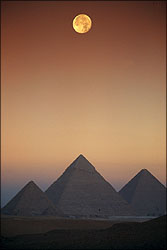
|
The Palace Hypothesis

 At Giza, evidence of the workforce that built the pyramids is slowly being
uncovered in archaeological explorations. However, one piece of the fabric of
ancient Egypt is still missing. There is no evidence of the structures which
must have housed the great kings of ancient Egypt. Giza itself is a necropolis, a
large-scale cemetery for dead kings. But where did these kings, their
attendants, and the laborers who built the pyramids live?
At Giza, evidence of the workforce that built the pyramids is slowly being
uncovered in archaeological explorations. However, one piece of the fabric of
ancient Egypt is still missing. There is no evidence of the structures which
must have housed the great kings of ancient Egypt. Giza itself is a necropolis, a
large-scale cemetery for dead kings. But where did these kings, their
attendants, and the laborers who built the pyramids live?
In the following interview with archaeologist Mark Lehner, he lays out his
palace hypothesis—that somewhere not far from the pyramids there must be
the remains of a grand residence for the pharaohs. Over the course of the next month, this web site will follow his
excavation closely to see if his team, in fact, does find a 4th Dynasty palace
from Egypt's Old Kingdom, a find that could be among the most significant in
archaeology in this century.
LEHNER: "All the older Egyptologists, the older generation who studied the evidence
from the texts for pyramid towns, pretty much agree that there was a palace or
a residence in each pyramid town. And these at Giza would be some of the
earliest pyramid towns. A palace of the Old Kingdom pyramid age has never been
found in Egypt. We do have palaces from the late middle kingdom, possibly, and
certainly from the new kingdom.
An Egyptologist named David O'Connor at the Institute of Fine Arts, did a
particular study of the palaces of the new kingdom. And he said, they tend to
be perpendicular outside the entrances of temples. So outside the great temple
of Karnac, as you come out of the temple, to your right hand, and perpendicular
to the temple axis would have been the palace, we know from text. This is
called 'imi werat' in Egyptian, to the right front. And there are some
examples of this. And we think that the palace was oriented north-south. And
the temple of Karnac, for example, is oriented east-west. And we know from
texts and representations that on great processions the king would come out of
his palace, oriented north-south, out into the plaza. And from the temple
would come the God, from his axis east-west, and King and God merged and
crossed, and these were the axes of the world. And then they would march off
to another temple for a great celebration.
Well, like I say, a palace of the Old Kingdom has never been found. But if you
look at the pyramid complexes as temples with their long causeways, and a
valley temple and an upper temple, they're oriented east-west. And if you were
coming down out of the Menkaure Pyramid complex at Giza, to the right front is
our (excavation) site, and indeed right there is the gigantic Wall of the Crow,
with its huge gateway. Now consider that in relation to the statement that I
made that 'they don't have Wonder Bread factories in ancient Egypt.' Bread
baking, brewing, weaving, woodworking, butchery, tend to be attached to large
houses. To which large house would our bakery be attached, with its walls all
running north-south and so rectilinear laid out, and all our seal impressions
of Menkaure? So we indeed have begun to consider the possibility that we are
at the back end of a palace. And that between us and the Wall of the Crow, to
the north, about 160 to 200 meters may lie the remains of perhaps the Palace of
Menkaure.
In archaeology, as in all modern science these days, it's not like an exam in
grad school. We don't get something right or wrong. We go out with a
hypothesis. And maybe we're wrong, but maybe we're right. But it certainly
organizes our strategy. So what we're going to be doing in the upcoming season
is to try to get windows onto the overall layout of our bakery and pull back
from this myopic focus, which is fascinating. But we need to pull back and
just get the major outlines of the walls and try to see what kind of a
structure we're dealing with, and indeed, whether we do have one of the missing
palaces. So we need to get a broader view and see if, in fact, we are at the
back end of one of the palaces, one of the missing palaces of the Giza Pyramid
kings."
Check back to the excavation newsflashes regularly to see if the bakeries are
really attached to a palace.
Photo: Aaron Strong
Pyramids Home | Pyramids | Excavation
Contents | Mail
|